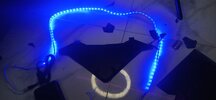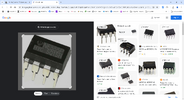StrayDoggo
New Member
Hi everyone,
I'm working on a project to make an LED that fades in and out (breathing effect) and operates on a 12V power source. I have the following components:
12v strip led
3x 3.7v batteries connected in series = 12v (with added extra voltage when fully charged resulting in 12v)
BC547 NPN Transistor
NE555 Timer
C817 Optocoupler
330uF 50V Capacitor
330uF 25V Capacitor
1000uF 25V Capacitor
1000uF 50V Capacitor
100k Potentiometer
15K Ohm 1/4W Resistor
10K Ohm 2W Resistor
100K Ohm 1/4W Resistor
1K Ohm 1W Resistor
4.7K Ohm 1/4W Resistor
Could someone guide me on how to wire these components to achieve the breathing effect? If any additional components or specific values are needed, I'd love some advice. I’d also appreciate any example circuits or explanations on how to calculate the timing for smooth fading.
Thanks in advance for any help!
I am not very good with circuit diagrams I am a visual learner, I also checked youtube but it didn't help me much and it was over complicated.
I'm working on a project to make an LED that fades in and out (breathing effect) and operates on a 12V power source. I have the following components:
12v strip led
3x 3.7v batteries connected in series = 12v (with added extra voltage when fully charged resulting in 12v)
BC547 NPN Transistor
NE555 Timer
C817 Optocoupler
330uF 50V Capacitor
330uF 25V Capacitor
1000uF 25V Capacitor
1000uF 50V Capacitor
100k Potentiometer
15K Ohm 1/4W Resistor
10K Ohm 2W Resistor
100K Ohm 1/4W Resistor
1K Ohm 1W Resistor
4.7K Ohm 1/4W Resistor
Could someone guide me on how to wire these components to achieve the breathing effect? If any additional components or specific values are needed, I'd love some advice. I’d also appreciate any example circuits or explanations on how to calculate the timing for smooth fading.
Thanks in advance for any help!
I am not very good with circuit diagrams I am a visual learner, I also checked youtube but it didn't help me much and it was over complicated.



